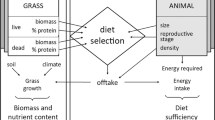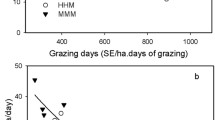Abstract
The introduction of domestic livestock, particularly sheep, and rangeland grazing by Norse settlers to Faroe during the ninth century has generally been described as a major pressure on a sensitive landscape, leading to rapid and widespread vegetation change and contributing to land degradation. This view has, however, been developed without consideration of Norse grazing management practices which may have served to minimize grazing impacts on landscapes as well as sustaining and enhancing vegetation and livestock productivity. These alternative scenarios are considered using a historical grazing management simulation model with Faroese climate and vegetation inputs and given archaeological, historical and palaeoenvironmental parameters. Three contrasting rangeland areas are investigated and, based on the maximum number of ewe/lamb pairs the rangeland could sustain, modeling suggests that utilizable biomass declined with the onset of grazing activity, but not to a level that would cause major changes in vegetation cover or contribute to soil erosion even under climatically determined poor growth conditions. When rangeland areas partitioned into what are termed hagi and partir are modeled, grazing levels are still within rangeland carrying capacities, but productivities are variable. Some rangeland areas increase biomass and livestock productivities and biomass utilization rates while other rangeland areas that were too finely partitioned were likely to suffer substantial decline in livestock productivity. Partitioning of rangeland is a likely contributor to long-term differentiation of landscapes and the relative success of settlements across Faroe beyond the Norse period.
Similar content being viewed by others
References
Adderley, W. P., and Simpson, I. A. (2005). Early Norse home-field productivity in the Faroe islands. Human Ecology 33: 711–736.
Albrethsen, S. E., and Keller, C. (1986). The use of the saeter in medieval Norse farming in Greenland. Arctic Anthropology 23: 91–109.
Arge, S. V. (1991). The Landnám in the Faroes. Arctic Anthropology 28: 101–120.
Arge, S. V. (1997). Í Uppistovubeitinum. Site and settlement. Fróðskaparrit 45: 27–44.
Arge, S. V. (2001). Forn búsetning heima á Sandi. Frødi 2: 5–13.
Arge, S., Sveinbjarnardóttir, G., Edwards, K. J., Buckland, P. C., and Simpson, I. A. (2005). Viking and medieval settlement in the Faroes. Human Ecology 33: 597–620.
Borchgrevink, A.-B. Ø. (1977). The Seter areas of rural Norway. A traditional multi-purpose resource. Northern Studies 9: 3–24.
Brandt, J. (1984). Landscape ecological information through statistical analysis of the territorial structure of a sheep grazing system, Faroe Islands. In Brandt, J., and Agger, P. (eds.), Methodology in Landscape Ecological Research and Planning. Volume III: Theme III Methodology of Data Analysis, International Association of Landscape Ecology, Roskilde, pp. 43–57.
Brandt, J. (1996). Sheep breeding on Eastern Sandoy. In Guttesen, R. (ed.), The Faeroe Islands Topographic Atlas, Det Kongelige Danske Geografiska Selskab and Kort & Matrikelstyrelsen, København, pp. 82–84.
Buckland, P. C., Dugmore, A. J., Perry, D., Savory, D., and Sveinbjarnardóttir, G. (1991). Holt in Eyjafjallasveit, Iceland: A palaeoecological study of the impact of Landnám. Acta Archaeologica 61: 267–271.
Dahl, S. (1970). The Norse settlement of the Faroe Islands. Medieval Archaeology 14: 60–73.
Danish Meteorological Institute (1998). The Climate of the Faroe Islands—With Climatological Standard Normals, 1961–1990, DMI, Copenhagen.
Edwards, K. J., Buckland, P. C., Craigie, R., Panagiotakopulu, E., and Stummann-Hansen, S. (1998). Landscapes at Landnám: Palynological evidence from Toftanes, Faroe Islands. Fróðskaparrit 46: 229–244.
Edwards, K. J., Borthwick, D., Cook, G., Dugmore, A. J., Mairs, K.-A., Church, M. J., Simpson, I. A., and Adderley, W. P. (2005). Landscape change in eastern Suðuroy, Faroe islands: A hypothesis-based approach to the determination of natural processes and human artifice. Human Ecology 33: 621–650.
Fosaa, A. M. (2001). A review of plant communities of the Faroe Islands. Fróðskaparrit 48: 41–54.
Fredskild, B. (1988). Agriculture in a marginal area—South Greenland from the Norse Landnam (A.D. 985) to the present (A.D. 1985). In Birks, H., Birks H. J. B., Kaland, P. E., and Moe, D. (eds.), The Cultural Landscape—Past, Present and Future, Cambridge University Press, Cambridge, pp. 381–393.
Fredskild, B. (1992). Agriculture in SW Greenland in the Norse period (A.D. 982–c. 1450). Journal of the European Network of Scientific Cooperation for Cultural Heritage 31: 39–43.
Friðriksson, S. (1972). Grass and grass utilization in Iceland. Ecology 53: 785–796.
Hallsdóttir, M. (1987). Pollen analytical studies of human influence on vegetation in relation to the Landnám tephra layer in southwest Iceland. Lundqua Thesis 18, Department of Quaternary Geology, Lund University.
Hannon, G. E., and Bradshaw, R. H. W. (2000). Impacts and timing of the first human settlement on vegetation of the Faroe Islands. Quaternary Research 54: 404–413.
Hannon, G. E., Wastegård, Bradshaw, E., and Bradshaw, R. H. W. (2001). Human impacts and landscape degradation on the Faroe Islands. Proceedings of the Royal Irish Academy 101B: 129–139.
Hansen, K., and Johansen, J. (1982). Flora and vegetation of the Faroe Islands. Monographiae Biologicae 46: 35–52.
Humlum, O., and Christiansen, H. H. (1998). Late Holocene climate forcing of geomorphic activity in the Faroe Islands. Fróðskaparrit 46: 169–189.
Jakobsen, B. H. (1991). Soil resources and soil erosion in the Norse settlement area of Østerbygden in southern Greenland. Acta Borealia 1: 56–68.
Jóhansen, J. (1981). Vegetational development in the Faroes from 10,000 BP to the present. DGU Årbog 1981: 111–136.
Lawson, I. T., Edwards, K. J., Arge, S., Dugmore, A. J., Church, M., Mairs, K.-A., and McGovern, T. H. (2005). Landscapes of southern Sandoy, Faroes, circum-Landnám. Human Ecology 33: 651–684.
Mahler, D. (1991). Argisbrekka. New evidence of shielings in the Faroe Islands. Acta Archaeologica 61: 60–72.
Melsteð, B., Jónsson, F., and þórlófsson, B. (eds.) (1990). Jaarðbók Árna Magnússonar og Páls Vídalín 1–11, Copenhagen.
RALA (1978a). Utilization and conservation of grasslands. Progress report 1976. Agricultural Research Institute, Iceland. RALA Report No. 29, Reykjavík.
RALA (1978b). Utilization and conservation of grasslands. Progress report 1977. Agricultural Research Institute, Iceland. RALA Report No. 38, Reykjavík.
RALA (1979). Utilization and conservation of grasslands. Progress report 1978. Agricultural Research Institute, Iceland. RALA Report No. 50, Reykjavík.
RALA (1980). Utilization and conservation of grasslands. Progress report 1979. Agricultural Research Institute, Iceland. RALA report No. 63, Reykjavík.
RALA (1981). Utilization and conservation of grasslands. Progress report 1980. Agricultural Research Institute, Iceland. RALA Report No. 79, Reykjavík.
Sandgren, P., and Fredskild, B. (1991). Magnetic measurements recording Late Holocene man-induced erosion in S. Greenland. Boreas 20: 315–331.
Simpson, I. A., Dugmore, A. J., Thomson, A., and Vésteinsson, O. (2001). Crossing the thresholds: Human ecology and historical patterns of landscape degradation. Catena 42: 175–192.
Simpson, I. A., and Guttmann, E. B. (2002). Transitions in early arable land management in the Northern Isles: The Papar as agricultural innovators? In B. Crawford (ed.), The Papar of the North Atlantic: Environment and History, St Andrews: St John's House Papers No. 10. pp. 59–67.
Simpson, I. A., Guðmundsson, G., Thomson, A. M., and Cluett, J. (2004). Assessing the role of winter grazing in land degradation, Mývatnssveit, northeast Iceland. Geoarchaeology 19: 471–502.
Stummann-Hansen, S. (1988). The Norse Landnam in the Faroe Islands in the light of recent excavations at Toftanes, Leirvik. Northern Studies 25: 58–84.
Thomson, A. M. (2003). A modeling approach to farm management and vegetation degradation in pre-modern Iceland. Unpublished PhD Thesis, University of Stirling.
Thomson, A. M., and Simpson, I. A. (in press a). Modeling historic rangeland management and grazing pressures, Mývatnssveit Iceland. Human Ecology.
Thomson, A. M., and Simpson, I. A. (in press b). Modeling the impact of historical land management decisions in sensitive landscapes: The construction of a grazing model for Iceland. Environmental Modeling and Software.
Thorsteinsson, L., Olafsson, G., and van Dyke, G. M. (1971). Range resources of Iceland. Journal of Range Management 48: 350–357.
Tierney, J. J. (ed.) (1967). Dicuilus. Liber de Mensura Orbis Terrae. Scriptores Latini Hiberniai 6 (Dublin).
Turrell, W., and Holliday, N. P. (2002). The Annual ICES Ocean Climate Status Summary 2001–2002. International Council for the Exploration of the Sea, Copenhagen.
Vésteinsson, O., McGovern, T. H., and Keller, C. (2002). Enduring impacts: Social and environmental aspects of Viking Age settlement in Iceland and Greenland. Archaeologia Islandica 2: 98–136.
Vickers, K., Bending, J., Buckland, P. C., Edwards, K. J., and Stummann-Hansen, S. (2005). Toftanes: The palaeoecology of a Faroese Landnám farm. Human Ecology 33: 685–710.
Winchester, A. J. L. (2000). The Harvest of the Hills. Rural Life in Northern England and the Scottish Borders, 1400–1700. Edinburgh University Press, Edinburgh.
Author information
Authors and Affiliations
Corresponding author
Rights and permissions
About this article
Cite this article
Thomson, A.M., Simpson, I.A. & Brown, J.L. Sustainable Rangeland Grazing in Norse Faroe. Hum Ecol 33, 737–761 (2005). https://doi.org/10.1007/s10745-005-7596-x
Issue Date:
DOI: https://doi.org/10.1007/s10745-005-7596-x




